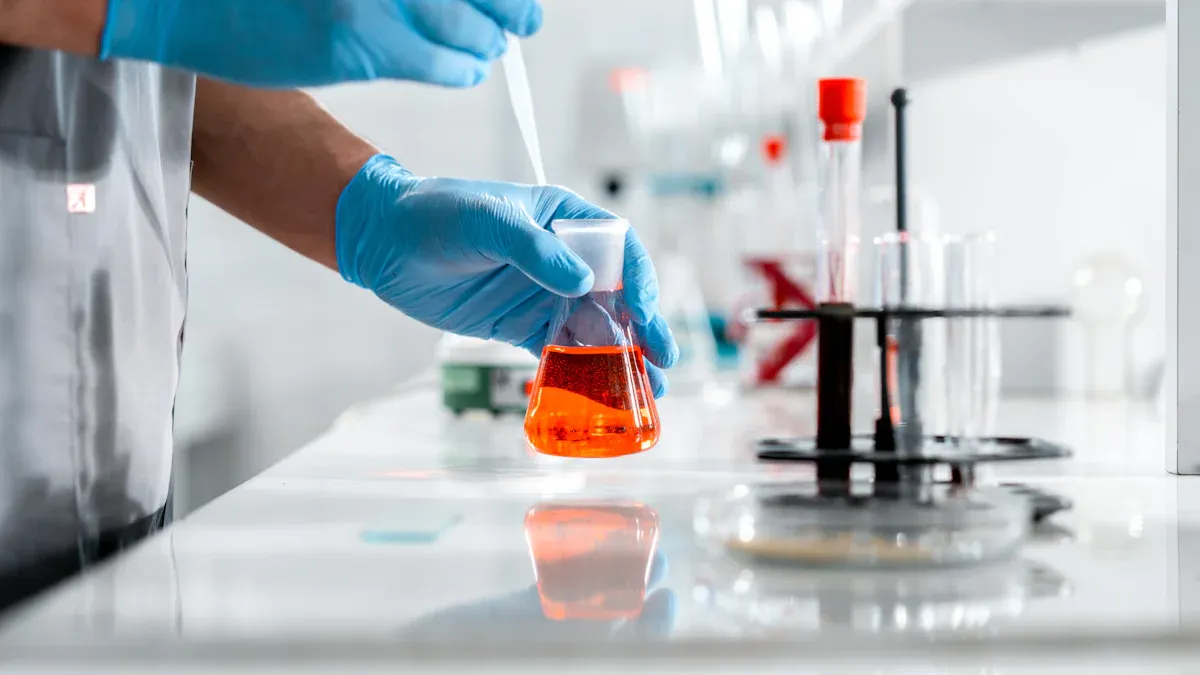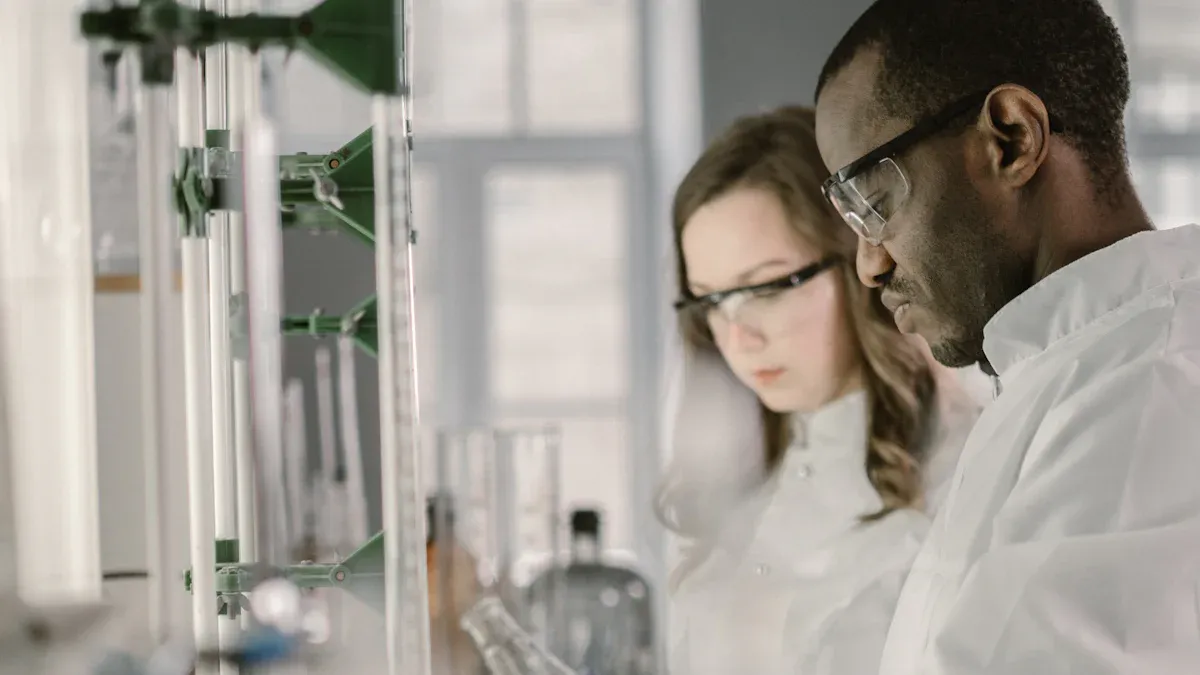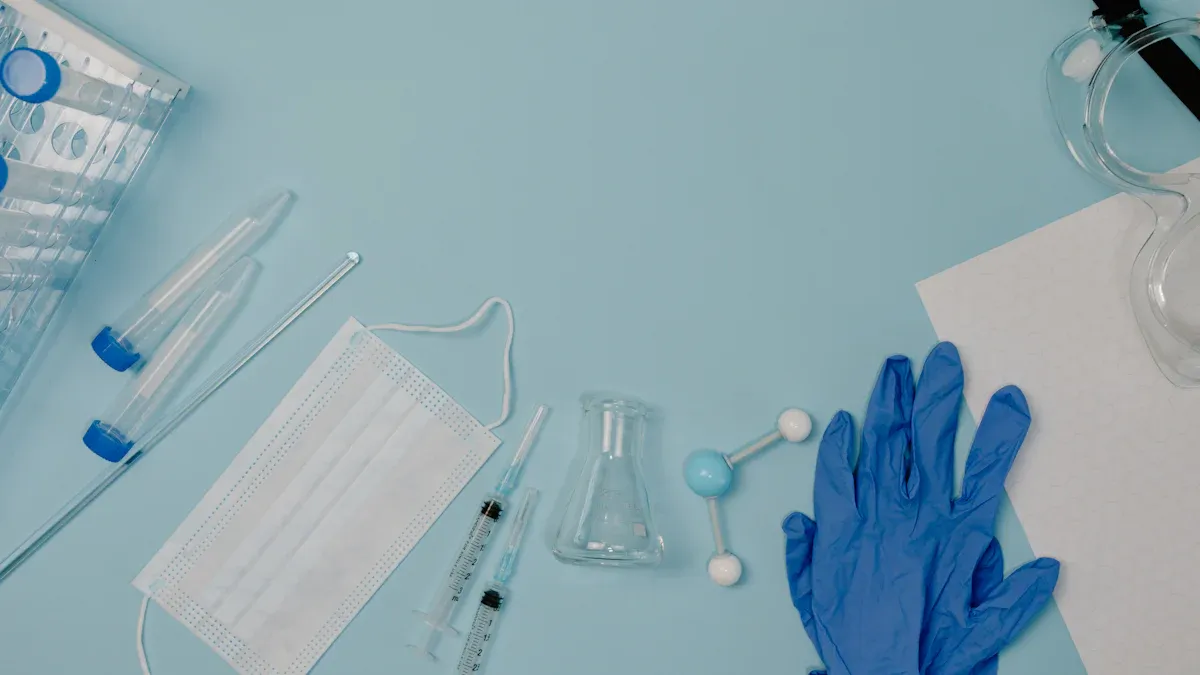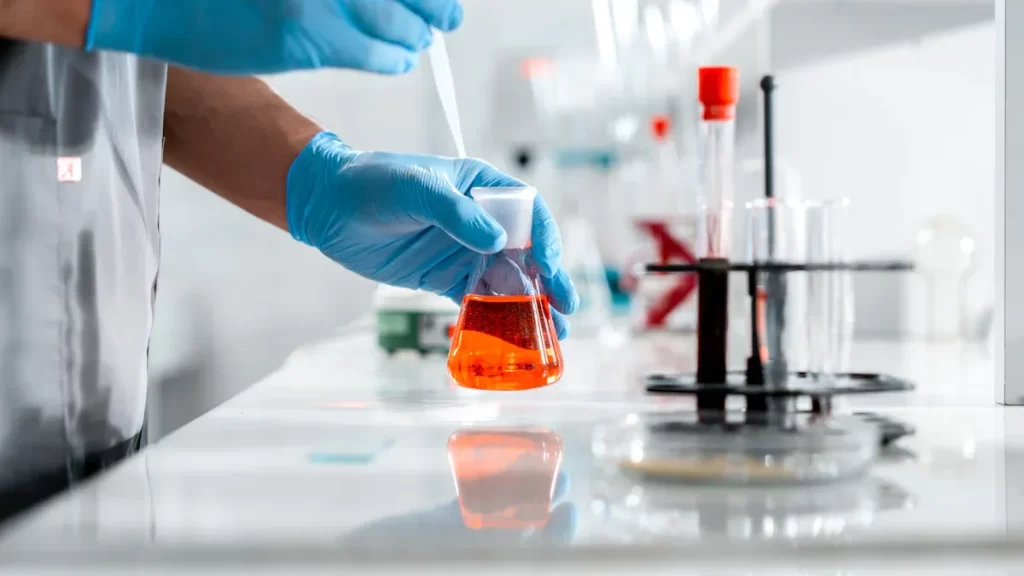News & Events
Ethyl Acetate SDS Safety Stories from Real Lab Users

When you use ethyl acetate with ethanol in a western blot test, you face serious safety risks. You must check the ethyl acetate sds before starting your protocols. Review the main hazards:
| Hazard Type | Description |
|---|---|
| Flammability | Highly flammable; easily ignited by heat, sparks, or flames. Vapors can form explosive mixtures with air. |
| Health Hazards | Can cause headache, respiratory irritation, dizziness, nausea, weakness, and loss of consciousness. |
| Reactivity Profile | Sensitive to heat; may form explosive peroxides on prolonged storage; incompatible with strong oxidizers and acids. |
Lab users often share stories about spills, missed PPE, and poor ventilation. You learn from these incidents. Always wear proper protection and work in a well-ventilated area to keep safety first.
Key Takeaways
- Always read the ethyl acetate SDS before starting any lab work. It provides crucial information about hazards and safety measures.
- Wear proper personal protective equipment (PPE) like gloves, goggles, and lab coats to prevent injuries from chemical exposure.
- Ensure good ventilation in the lab. Use fume hoods to control vapors and reduce the risk of fire and health issues.
- Store ethyl acetate and ethanol in separate, labeled containers away from heat sources to prevent accidents.
- Act quickly in case of spills. Know your lab’s spill response plan and keep a spill kit accessible at all times.
Ethyl Acetate SDS Essentials
Hazards and Risks
You must understand the main hazards before you use ethyl acetate in your lab. The ethyl acetate sds lists several risks that you cannot ignore. Ethyl acetate can cause headaches, dizziness, and breathing problems if you breathe in the vapors. If you spill it on your skin, you may feel irritation or dryness. You should always check the sds for health warnings and first aid steps.
When you compare ethyl acetate to other solvents, you see some important differences:
- Ethyl acetate is less toxic than hexane and dichloromethane.
- It does not explode as easily as some other solvents.
- It is more environmentally friendly because it needs less energy to process.
- Both ethyl acetate and ethanol are safer for food use than many other chemicals.
You must always read the ethyl acetate sds before you start your work. The sds will tell you about the risks and how to protect yourself. You should also look for information about static discharge, which can ignite vapors. Always wear gloves, goggles, and a lab coat. Never work alone when you use hazardous chemicals.
Flammability and Ventilation
Ethyl acetate is a highly flammable liquid. The ethyl acetate sds gives you important numbers to remember:
| Property | Value |
|---|---|
| Flash Point | -4 °C |
| Major Hazards | Flammable liquid and vapor |
| Flammability Rating | NFPA 3 |
| Explosive Mixture Range | 2 to 11.5% (by volume) |
You must keep ethyl acetate away from heat, sparks, and open flames. Vapors can travel and ignite far from where you use the chemical. The sds says you should only use ethyl acetate in areas with good ventilation. You need at least 6 air changes per hour in your lab. Use continuous exhaust ventilation to keep vapors from building up. The fire code also requires an exhaust rate of 1 cfm per square foot in rooms where you use or store hazardous materials.
Tip: Always check that your fume hood or exhaust system works before you start. Never use ethyl acetate near electrical equipment that can spark.
Store ethyl acetate in tightly sealed metal containers if you have more than 1 liter. Keep it away from oxidizers and acids. The sds will give you more details about safe storage.
Incompatibilities with Ethanol
You may use ethyl acetate with ethanol in western blotting, but you must know about their incompatibilities. The ethyl acetate sds warns you not to mix it with strong oxidizers or acids. Ethanol is also flammable, so mixing the two increases the fire risk. Both chemicals can form explosive vapors if you do not use proper ventilation.
- Store ethyl acetate and ethanol in separate, labeled containers.
- Do not store them near oxidizers or sources of heat.
- Always check the sds for both chemicals before you mix or use them together.
If you follow the sds instructions, you lower your risk of fire, explosion, and health problems. You also protect your lab and your coworkers. Always review the ethyl acetate sds and the sds for any other chemicals you use. Make safety your top priority every time you work in the lab.
Real Lab Safety Stories

Spill Response
You may think spills only happen to new lab workers, but even experienced scientists make mistakes during western blotting. One researcher shared a story about dropping a flask of ethyl acetate while preparing a protein transfer. The liquid spread across the bench and onto the floor. The strong smell filled the room. The researcher quickly alerted others and used absorbent pads to clean the spill. The team opened windows and turned on the fume hood. No one got hurt, but the lab had to stop work for an hour. You learn that quick action and teamwork help keep everyone safe. Always know where your spill kit is before you start western blotting.
PPE Oversight
You may forget your gloves or goggles when you rush to set up western blotting. One lab technician shared a story about skipping gloves because the task seemed simple. Ethyl acetate splashed onto their hand during a buffer mix. The technician felt burning and washed the area right away. The skin turned red and dry. The technician had to report the incident and see a doctor. You see that even small mistakes can cause harm. Always wear gloves, goggles, and a lab coat when you handle ethyl acetate or ethanol in western blotting.
Storage Errors
You may store chemicals in the wrong place if you do not check the labels. One lab stored ethyl acetate and ethanol together near a heat source. During western blotting, a spark from nearby equipment caused a small fire. The team used a fire extinguisher and called safety staff. No one got injured, but the lab lost valuable samples. You learn that proper storage prevents accidents. Always keep ethyl acetate and ethanol in separate, labeled containers away from heat and oxidizers.
A tragic case in scientific literature describes a fatal accident with ethyl acetate. A worker died after exposure in a tank containing the chemical. This story reminds you that safety rules protect lives, not just samples.
| Lesson Learned | Action Step |
|---|---|
| Spills can happen fast | Know your spill kit location |
| PPE prevents injuries | Wear gloves, goggles, lab coat |
| Storage errors cause fires | Store chemicals safely |
You protect yourself and others when you follow safety steps in every western blotting protocol.
Safety Tips for Western Blotting
Handling and PPE
You handle ethyl acetate and ethanol every time you set up western blotting or prepare for protein transfer. You must protect yourself from chemical exposure. Always wear gloves that resist solvents, such as nitrile gloves. Put on a lab coat and safety goggles before you start. You need to check that your PPE fits well and covers your skin. Change gloves if they get wet or damaged during protein transfer.
Work in a well-ventilated area. Turn on the fume hood before you open any container. You should never pipette by mouth. Use pipette tips and avoid splashing. Keep your workspace clear of clutter. If you spill ethyl acetate or ethanol, you must act fast. Alert your team and follow your lab’s spill response plan.
Tip: Always check the SDS for ethyl acetate and ethanol before you begin western blotting. The SDS will tell you about health risks and first aid steps.
Storage and Labeling
Proper storage keeps you safe during western blotting and protein transfer. Store ethyl acetate in a ventilated cupboard that can withstand fire. Keep the original container if possible and make sure it is airtight. Place ethanol in a separate, labeled container. You must keep both chemicals away from heat sources and direct sunlight.
Use containers designed to minimize exposure to air and light. Control the temperature in your storage area. Do not store ethyl acetate or ethanol in closed drawers. This prevents solvent concentration and reduces fire risk. Check the shelf life of each chemical before you use it for protein transfer. Old solvents can degrade and affect your results.
Label every container with the chemical name, concentration, and date received. You need to update labels if you transfer chemicals to new containers. This helps you avoid mix-ups during western blotting.
- Store ethyl acetate in a fire-resistant, ventilated cupboard.
- Keep containers airtight and away from ignition sources.
- Label all containers clearly with name, concentration, and date.
- Monitor shelf life and temperature for consistent protein transfer results.
Spill and Disposal Procedures
Spills can happen during western blotting or protein transfer. You must know how to respond. If you spill ethyl acetate or ethanol, alert everyone in the lab. Use absorbent pads to soak up the liquid. Wear gloves and goggles during cleanup. Open windows and turn on the fume hood to remove vapors.
Dispose of used pads and contaminated gloves in a chemical waste bin. Never pour ethyl acetate or ethanol down the drain. Follow your lab’s chemical disposal protocol. You should keep a spill kit nearby every time you work with solvents.
Note: Always review the SDS for disposal instructions before you start protein transfer. The SDS will guide you on safe waste handling.
You protect yourself and your team when you follow these safety tips. You keep your lab safe and your protein transfer results reliable. Western blotting works best when you put safety first.
| Safety Step | Why It Matters |
|---|---|
| Wear PPE | Prevents skin and eye injuries |
| Use ventilation | Reduces vapor exposure and fire risk |
| Store chemicals properly | Lowers accident risk |
| Label containers | Avoids mix-ups during protein transfer |
| Clean spills quickly | Limits exposure and contamination |
| Dispose of waste safely | Protects people and the environment |
Common Mistakes in Protein Transfer
Handling Errors
You may face many challenges during the transfer of proteins in protein blotting. One common mistake is rushing through the setup. You might forget to check the alignment of the membrane and gel. If you do not handle the membrane with care, you can damage the proteins or lose them during the transfer of proteins. Sometimes, you may use the wrong buffer or mix up the order of layers. This can lead to poor transfer of proteins and weak antibody signals in your protein blotting results.
Another frequent error is using contaminated tools. If you do not clean your tweezers or trays, you risk introducing unwanted proteins or chemicals. This can affect the transfer of proteins and make your antibody detection less reliable. Always use clean equipment and double-check your setup before starting the transfer of proteins.
Ignoring SDS Warnings
You must always read the SDS before you begin protein blotting. Some users skip this step and miss important safety information. If you ignore the warnings, you may expose yourself to harmful vapors or spills during the transfer of proteins. Ethyl acetate and ethanol both require careful handling. If you do not follow the SDS, you might forget to wear gloves or goggles. This can lead to skin irritation or eye injuries during protein blotting.
You also need to pay attention to disposal instructions. Many labs have seen accidents because someone poured solvents down the drain after protein blotting. Improper disposal can harm the environment and break lab rules. Always follow the SDS for safe disposal after the transfer of proteins.
Prevention Strategies
You can avoid most mistakes in protein blotting by following a few simple steps:
- Review the SDS for each chemical before starting the transfer of proteins.
- Wear gloves, goggles, and a lab coat every time you handle proteins or solvents.
- Use clean tools and label all containers during protein blotting.
- Store ethyl acetate and ethanol in separate, safe locations.
- Follow proper disposal steps after each transfer of proteins.
Some labs use rapid solidification techniques to protect proteins during the transfer of proteins. This method helps keep the structure of proteins stable and improves antibody detection in protein blotting. You can also add a preliminary solidification step to your transfer protocols. This step reduces the time proteins spend in contact with solvents, making the transfer of proteins safer and more effective.
Tip: Always check your antibody and protein blotting supplies before starting. Careful planning helps prevent mistakes during the transfer of proteins and ensures proper disposal.
| Mistake | How to Prevent It |
|---|---|
| Rushing setup | Double-check membrane and gel alignment |
| Ignoring SDS | Read warnings and follow instructions |
| Improper disposal | Use correct disposal containers |
| Contaminated tools | Clean all equipment before use |
| Poor antibody results | Use rapid solidification and proper buffers |
You can achieve better results in protein blotting by avoiding these mistakes. Careful handling, attention to SDS, and proper disposal keep your transfer of proteins safe and effective.
Quick Safety Checklist

Pre-Use Steps
Before you start working with ethyl acetate and ethanol, you need to prepare your workspace and yourself. Follow these steps to stay safe:
- Check that your fume hood or extractor works well.
- Put on chemical-resistant gloves, safety goggles, and a lab coat.
- Make sure you have protective sleeves if your arms are exposed.
- Read the SDS for both chemicals before you begin.
- Label all containers with the chemical name and date.
- Keep your spill kit nearby and know how to use it.
Tip: Always inspect your PPE for damage before you start. Replace any torn gloves or broken goggles.
During Use Protocols
When you handle ethyl acetate and ethanol, you must follow strict safety rules. These steps help you avoid exposure and accidents:
- Work inside a fume hood or use a fume extractor to control vapors.
- Keep chemicals away from heat, sparks, and open flames.
- Use pipette tips and avoid splashing liquids.
- Never pipette by mouth.
- Handle chemicals with care and avoid rushing.
- Follow your lab’s safety protocols at every step.
Exposure to solvents can harm your health. You may face problems like headaches, skin irritation, or breathing trouble. Long-term exposure can damage your nervous system, liver, or kidneys.
| Safety Protocol | Why It Matters |
|---|---|
| Use PPE | Prevents injuries |
| Use ventilation | Reduces vapor exposure |
| Follow procedures | Lowers risk of accidents |
Post-Use Cleanup
After you finish your experiment, you need to clean up safely. Proper cleanup protects you and your lab:
- Dispose of used gloves, pads, and other waste in a chemical bin.
- Never pour ethyl acetate or ethanol down the drain.
- Wipe down surfaces with water and detergent.
- For peptide samples, dilute with ammonium bicarbonate, add water-saturated ethyl acetate, shake, and centrifuge. Discard the upper layer and evaporate the bottom phase with a vacuum concentrator.
- Wash your hands and check that all containers are sealed and stored correctly.
Note: Always follow your lab’s disposal protocol and check the SDS for special instructions.
By following this checklist, you keep yourself and your lab safe every time you use ethyl acetate and ethanol.
You keep your lab safe when you follow clear safety steps with ethyl acetate and ethanol. Real stories show that teamwork, proper PPE, and quick spill response matter. Sharing your own safety stories helps everyone learn and makes risks feel real.
- Always review the SDS before each protocol.
- Use training, clear labels, and regular safety checks.
- Encourage open discussion about near-misses.
| Method | Description |
|---|---|
| Training | Regular sessions on hazards and safe handling |
| Sharing Experiences | Stories make safety rules easier to remember |
| Proper Labeling | Clear labels prevent mix-ups and accidents |
Stay alert, share your experiences, and help build a safer lab for everyone.
FAQ
What is the role of sodium dodecyl sulfate polyacrylamide gel electrophoresis in immunoblotting?
Sodium dodecyl sulfate polyacrylamide gel electrophoresis separates proteins by size. You use this method before transfer to a membrane for immunoblotting analysis. This step helps you prepare samples for antibody binding and detection.
How do you safely handle ethyl acetate and ethanol during western blotting?
You must review the sds for both chemicals. Wear gloves, goggles, and a lab coat. Use a fume hood to control vapors. Store each solvent in a labeled container away from heat. Follow all transfer and disposal methods for safe blotting.
Why is membrane selection important for immunodetection of proteins?
You choose a membrane based on your detection needs. Nitrocellulose works well for antibody binding and immunodetection. PVDF is another option for immunoblotting analysis. The right membrane improves transfer and detection during blotting.
What steps help prevent mistakes during protein transfer in blotting?
You check the sds before starting. Align the gel and membrane carefully. Use clean tools for transfer. Label all containers. Follow methods for safe handling and disposal. These steps help you avoid errors in immunoblotting and detection.
How does antibody binding affect detection in immunoblotting?
Antibody binding allows you to target specific proteins on the membrane. You use detection methods to visualize results. Proper transfer and blotting improve immunodetection and accuracy in immunoblotting analysis.

